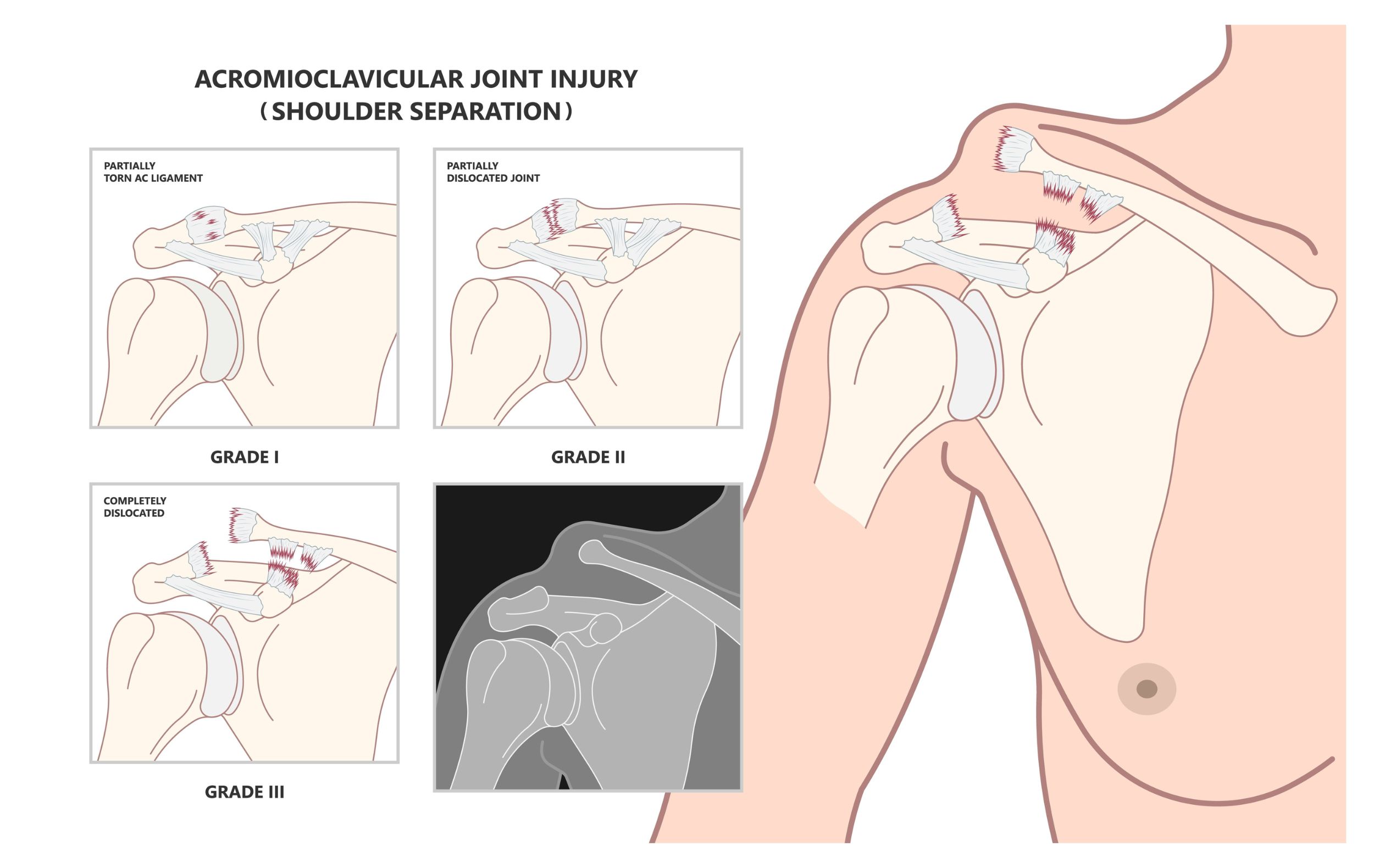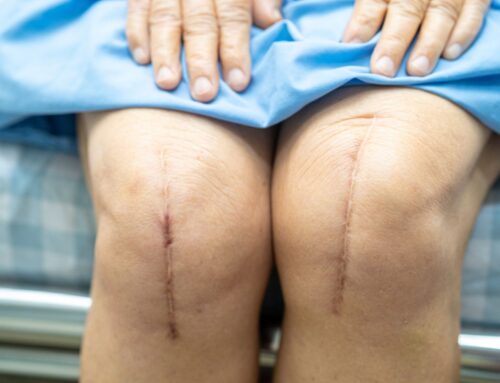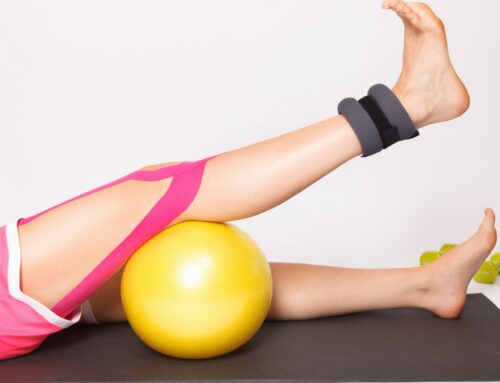Acromioclavicular (AC) joint separation is usually the result of a direct force to the top of the shoulder or a fall directly onto it. The approach to AC joint separation treatment depends on the degree of the injury. The good news is most people will recover full function of their shoulder within a few weeks to a few months.
Physiotherapists are able to identify and treat AC joint separation and are the first line in conservative management for these injuries. Through understanding of the mechanism of injury, specific testing and movement analysis, physiotherapists can help guide the treatment process.
In this blog, we will look at the different grades of separation and how they impact the physiotherapy treatment approach and recovery times.
Table of Contents
- What is acromioclavicular joint separation?
- Grades of AC joint separations
- AC joint separation treatment: physiotherapy for grade i-iii
- AC joint separation recovery times
- AC joint separation treatment for grade iv-vi
- Conclusion
What is Acromioclavicular Joint Separation?
Acromioclavicular (AC) joint separation, also known as shoulder separation, involves a stretch or tear of ligaments that connect the acromion (a section of the shoulder blade) and the clavicle/collarbone.[i]
AC joint separation is commonly caused by a fall directly on the point of the shoulder or a direct blow received in contact sports. Football players and cyclists who fall over the handlebars are often subject to AC joint separations.[ii]
Depending on the degree of the stretch, tear, and/or separation, they are graded from I-VI (with I being the least severe and VI being the most).
You may also enjoy reading: Ankle Sprain Physiotherapy
Grades of AC Joint Separations
AC joint separations are based on the degree of the injury and structures affected as outlined below:[iii]
| Grades | Description | Test | Imaging |
| I | Sprain of AC ligaments. The AC and CC ligaments are intact | No instability of clavicle detected on stress tests | X-ray normal |
| II | AC ligaments are ruptured, CC ligaments are intact | Clavicle is unstable to direct stress tests | Lateral clavicle may be slightly elevated, negative stress views on x-ray |
| III | Complete disruption of both the AC and CC ligaments without significant disruption of the delto-trapezial fascia | Deformity present with clavicle appearing elevated (acromion depressed), clavicle unstable in both vertical and horizontal plane | Separation of the clavicle from the acromion especially evident with stress x-ray. |
| IV | Distal clavicle is posteriorly displaced into trapezius muscle | Posterior deformity present | Displaced clavicle evident on axillary x-ray view |
| V | More severe form of grade III. Complete disruption of both the AC and CC ligaments with disruption of the deltotrapezial fascia | Significant tenting or pseudo lateral clavicle elevation, downward displacement of the scapular | 2- to 3-fold increase in the CC distance or a 100–300% increase in the clavicle-to- acromion distance on x-ray |
| VI | Inferior displacement of the distal clavicle, either subacrominal or subcoracoid | Severe trauma, usually accompanied by other significant injuries |
You may also enjoy reading: High Ankle Sprain Rehab
AC Joint Separation Treatment: Physiotherapy for Grade I-III
Treatment of an AC joint separation depends on the grade of the injury. According to the literature review many studies indicated that conservative care is recommended for grade I and II injuries, and the early management of grade III injuries.i
Conservative care for AC joint separations may include the following treatment techniques:
- Protection: Protection involves reducing the load placed upon the AC joint during the initial stages. It may involve immobilizing the joint with a sling or lifestyle modifications to temporarily avoid painful movements and activities (for example, overhead or pressing movements).
- Soft tissue mobilization and assisted stretching: If muscle flexibility is affecting shoulder girdle motion, your healthcare provider may perform joint movements or stretching techniques to the affected muscles.
- Pain relief modalities: Your healthcare provider may also utilize modalities to decrease the symptoms experienced with activities or exercises. This can include the following:
- Acupuncture
- Transcutaneous electrical nerve stimulation (TENS) or electrical muscle stimulation (EMS)
- Kinesio-taping
- Therapeutic exercises:
- Range of motion or stretching exercises: to maintain and regain the flexibility of the shoulder girdle.
- Strengthening exercises: These exercises will focus on strengthening the muscles around the scapula (shoulder blade), rotator cuff, and deltoid. By strengthening and working on the co-ordination of these muscles, it will build stability of the shoulder in different positions and actions. This includes exercises like wall push-ups, banded
- Plyometric exercises: These exercises are performed at higher speeds compared to strengthening and range of motion exercises. Examples include medicine ball tosses and catches.
You may also enjoy reading: Does Ice Help with Inflammation
AC Joint Separation Recovery Times
Recovery time varies from patient to patient with factors such as age, accompanying injuries, and previous health and activity level affecting healing time. Most patients will recover full function of their shoulder within the timeline depending on the severity of the separation.
A grade I may take a few weeks, grade II six weeks and a grade III approximately 12 weeks. Most people resume full activity at this 3-month period. Osteoarthritis and degenerative changes may occur later in life with this type of injury.
The following are the guidelines for return to sport (following conservative treatment):i
- Grade I: 2-4 weeks
- Grade II: 4-6 weeks
- Grade III: 6-12 weeks
AC Joint Separation Treatment for Grade III to VI
With Grade III to VI injuries, there is currently a lack of consensus on the appropriate management options. A study by Giuseppe Longo et al. (2017) showed similar clinical outcomes (regarding pain, osteoarthritis prevention, and other outcome measures) between conservative and surgical management groups. However, pain persistence was less common in the surgical management group.
They recommended considering the following factors when deciding on conservative versus surgical management for AC joint injuries:
- Working environment requiring sustained shoulder flexion/abduction.
- Heavy lifting work requirements.
- Pain not allowing patients to return to sport/work for greater than 4 weeks.
You may also enjoy reading: Knee Osteoarthritis Physiotherapy
Conclusion
AC joint separation treatment that can include protection, soft tissue mobilization and assisted stretching, pain relief modalities and therapeutic exercises can help you get back to the activities you love.
The team of healthcare providers at Propel Physiotherapy can help with developing a treatment program specific for your symptoms and goals, or to refer you to an appropriate healthcare professional. To learn more about AC joint treatment, connect with one of our clinicians at Propel Physiotherapy in Etobicoke, Pickering, or Peterborough.
References
[i] Reid, Duncan, Kate Polson, and Louise Johnson. “Acromioclavicular joint separations grades I–III: a review of the literature and development of best practice guidelines.” Sports medicine 42 (2012): 681-696.
[ii] https://www.thesteadmanclinic.com/patient-education/shoulder/ac-separation
[iii] Rockwood C, Williams G, Young D. Disorders of the ac- romioclavicular joint. 2nd ed. In: Rockwood Jr C, Mat- terson F, editors. The shoulder. Philadelphia (PA): WB Saunders, 1998: 483-553
iii Longo, Umile Giuseppe, et al. “Surgical versus conservative management of Type III acromioclavicular dislocation: a systematic review.” British medical bulletin 122.1 (2017): 31-49.
Written by










